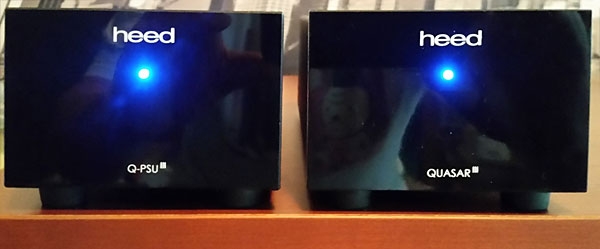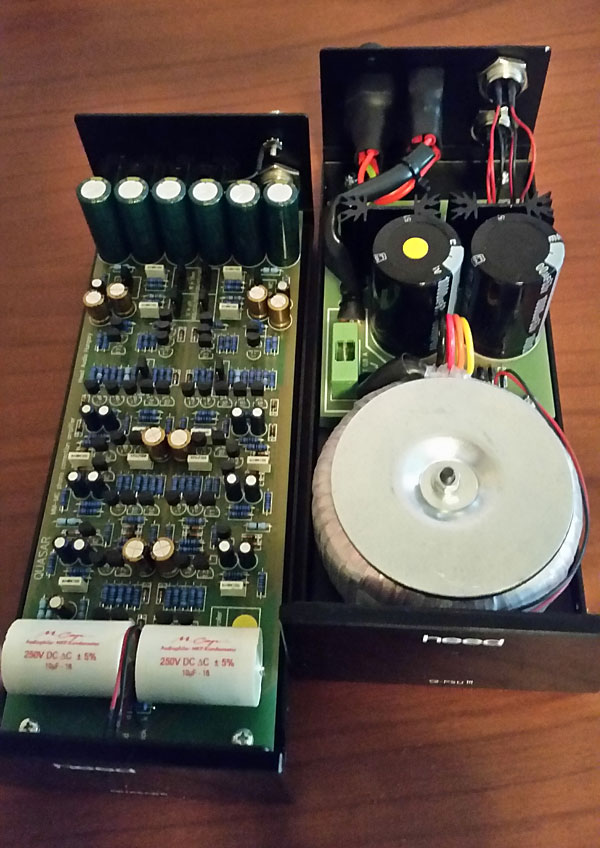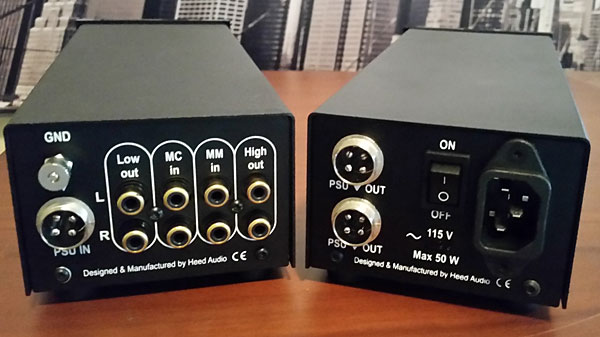| Columns Retired Columns & Blogs |
Wow! someone on ebay got a great deal recently - only $760.00 - 1568 Original Mono RVG.

First, I gave him a battered Thorens TD 166 Mk.II turntable and Cambridge Audio amplification. More recently, a pair of Snell J/Type II speakers pushed aside his old Tannoys. Then he sprang for a Music Hall MMF-7.3 turntable. My brother's endless questioning of every corner of my supposed audio expertise has made me rethink long-settled opinions.
Searching for information about the Quasar phono preamplifier and its Q-PSU power supply ($1200 for both), made by the Hungarian company Heed Audio, sent me down a path similar to my brother's quest for hi-fi. Luckily, the Quasar's designer, Zsolt Huszti, was able to answer a few of my questions.
Design
The Quasar is a dual-mono phono stage with an outwardly identical standalone power supply, the Q-PSU. Each of the two oblong, sleek'n'slender steel cases has a stark black faceplate with a single blue LED and four rubber feet. Each unit has a screw-in receptacle for the 1m-long, four-pin DIN umbilical cable that links them. Like the Heed Elixir integrated amplifier, the Quasar is well built and feels very solid.
Inside the Q-PSU is a single 117V/60V toroidal transformer. The mains transformer has two sets of output windings, each of which drives its own regulated power supply, starting with two independent rectifier sections" with two Jamicon 10,000µF electrolytic "smoothing" capacitors (wrote Zsolt). On the rear panel are an On/Off switch and an IEC inlet for the removable power cord.

Inside the Quasar itself is a single circuit board densely populated with: two German-made, polypropylene, 10µF Mundorf MCaps; six smaller 47,000µF capacitors; various resistors; and a series of minuscule, square jumpers for selecting the moving-coil (MC) input's impedance (100, 220, 470 ohms) and sensitivity (100, 220, 600µV). Four more tiny jumpers enable the choice of moving-magnet (MM) or MC cartridge. It was easy to get lost when searching for these little black jumpers—my eyes scoured the green circuit board like Gulliver searching for Lilliputians.
"The Quasar has two basic circuits," Huszti wrote via e-mail. "Both are fully discrete (all transistors, no ICs). The MM section provides RIAA compensation and gain. Via the MM/MC jumpers, the MC section is connected in front of the MM section as a pre-preamplification section. It provides gain and loading adjustment for MC cartridges, as well as a gain section to bring the voltage of the MC cartridge up to the level of an MM cartridge, for input into the MM section."
On the Quasar's rear panel are two pairs of RCA input jacks—one pair each for MM and MC cartridges—and a pair each of Low Out and High Out RCA jacks. There are also a small ground screw and a DIN receptacle for the cable from the power supply. Most of this is easy to access, even for the clumsy-fingered. In the Quasar's manual is this odd passage: "'Low Out' is recommended for older amplifiers of the '70s and '80s. The 'High Out' is aimed at more modern amplifier designs."
Huszti explained: "The manual is referring to the tendency of many modern integrateds and line-stages to use less gain, which can lead to a sense of less dynamics, unless the input voltage reaches a certain threshold. . . . The 'High Out' section indeed has more gain and generally sounds more dynamic, but with a certain sacrifice of transparency and immediacy. Since the Quasar has a lot of headroom before being overdriven, I recommend using the highest gain position of the adjustable gain jumpers (100µV), using the 'Low Out' with MC cartridges that have an output below 0.5mV. Listening bears this out pretty quickly." It most certainly did, but more about that later.
Incidentally, the Quasar's manual suggests sensitivity and impedance settings for various MC cartridges, including the Dynavector Karat 17D2 (100µV, 100 ohms), Goldring Eroica and Excel (220µV, 100 ohms), Audio Note Io (100µV, 100 ohms), and Lyra Lydian (220µV, 470 ohms).
"The input sensitivity and loading jumpers are only in the circuit when using MC," US distributor Bob Clarke explained via e-mail. "For MC loading, it's best to follow the manufacturer's recommendation; however, it is always good to experiment a little. For 0.5mV to about 0.8mV carts, I use the 220µV setting, then the 600µV for anything over that, until you reach MM output levels."
Setup
Finding room for the oblong Heeds proved problematic. I didn't have an extra shelf to devote to them in either system, so was forced to position them somewhat haphazardly. I ultimately sandwiched the Quasar between my Shindo Allegro preamplifier and the Heed Elixir, and perched the Q-PSU on a wooden stool.

I typically run my Denon DL-103 MC cartridge, via an Auditorium A23 step-up transformer (SUT), into the MM inputs of the Shindo Allegro. The Heed Quasar wasn't having any of that. No matter the internal arrangement or rearrangement of its jumpers or switching of interconnects from High to Low Outs, the sound was clear and spacious but lacking in bass fundamentals and weight. After e-mailing Bob Clarke and speaking with our own Art Dudley, I concluded that the culprit was impedance mismatch. I removed the Auditorium A23 SUT and plugged my Kuzma Stabi turntable and Stogi tonearm's interconnects straight into the Quasar's MC RCA jacks. Problem solved: musical peace and harmony restored. I did the same with my Music Hall MMF-7.3 turntable and Ortofon Bronze MM cartridge, plugged into the Quasar's MM RCAs.
I left the Quasar and Q-PSU powered on 24/7, as directed.
Blue Notes
Lately I've had the pleasurable job of selling part of a friend's collection of 7000 Blue Note LPs—the "off-condition" copies, which can still command considerable sums from cash-flush bidders around the globe. Another friend sells our mutual friend's mint-condition vinyl. He got $4539 for a copy of a deep-grooved pressing of Hank Mobley's eponymous album of 1957 (Blue Note BLP 1568), the LP's dead wax stamped "RVG" (for engineer Rudy Van Gelder) and "P" (for Plastylite).
The increasing value and collectibility of original Blue Note LPs is easy to explain. Even in less-than-pristine, VG- condition, original pressings of Blue Note's 1500 series (1952–1958) practically defy physics. Though pops and ticks may mar the vinyl's surface, the imperfections can't defile the music stamped in the deep grooves of these discs, which often weigh 220gm. The brilliance of Rudy Van Gelder's engineering and lacquer-cutting skills is absolutely, spectacularly, holographically present in such 1500-series titles as The Magnificent Thad Jones (BLP 1527) and Curtis Fuller's The Opener (BLP 1567), as well as such as 4000-series (1957–1972) LPs as Freddie Hubbard's Goin' Up (BLP 4056) and Mobley's The Turnaround (BLP 4186). Magnificent dynamics, naturalness, presence, tonal saturation, lucidity—and heart-thrilling music—are what I hear when I spin these discs on my Kuzma or Music Hall turntables.

Wow! someone on ebay got a great deal recently - only $760.00 - 1568 Original Mono RVG.

+2db boost in the bass, and slight treble boost, way off following the correct riaa curve.
Cheers George

this could be a great audiophile bargain. I've been looking to upgrade from an old EAR 834 for a while. Love the looks of these components as well. The Gold Note PH-10 - not reviewed in Stereophile yet but in some other on-line pubs also seems to a contender.